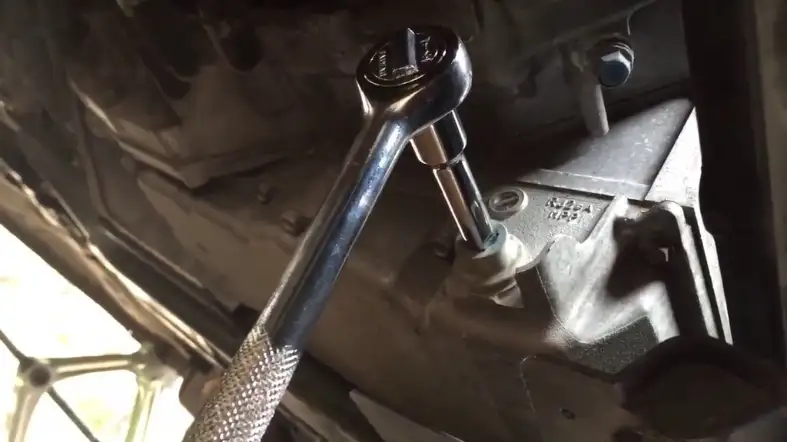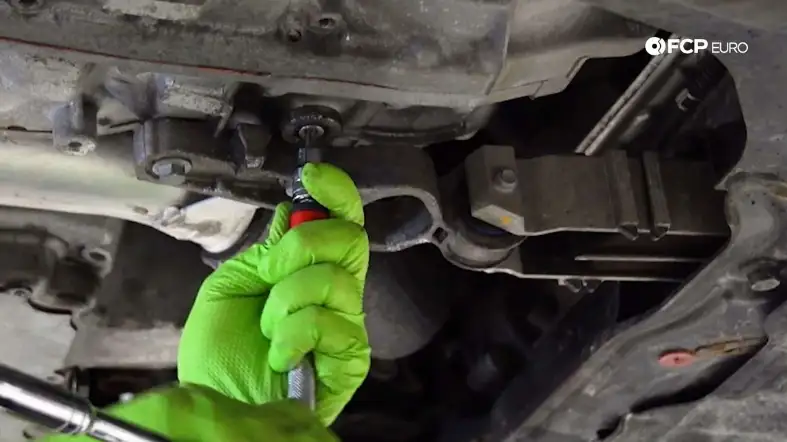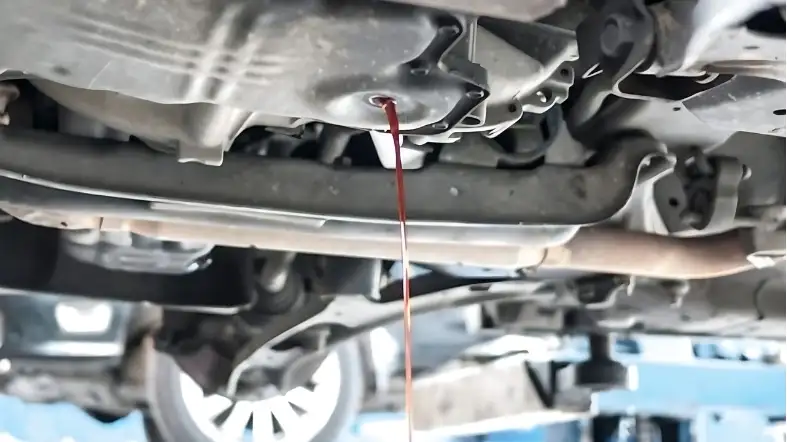Regular maintenance is essential to keep your vehicle running smoothly.
One of the most important aspects of maintenance is checking and changing the fluids in your car’s transmission.
However, this task can be challenging if the transmission fill plug gets stuck.
A stuck fill plug can make it difficult to access and change the transmission fluid, which can lead to costly repairs in the future.
In this blog post, we will discuss how to remove a stuck transmission fill plug.
How To Remove Stuck Transmission Fill Plug?
Here are some steps you can follow to remove a stuck transmission fill plug:

Step One
Allow the vehicle’s transmission to cool down completely before attempting to remove the plug. This is to avoid injury or damage to the transmission due to the hot fluid.
Step Two
2. Spray a penetrating oil such as PB Blaster, Liquid Wrench, or WD-40 on the plug and let it sit for at least 15 minutes.
The oil will penetrate and loosen any rust or debris that may be causing the plug to be stuck.
Step Three
Use a socket wrench or a breaker bar with the correct size socket to try and loosen the plug.
Make sure the socket is fully seated on the plug and turn it counterclockwise.
If the plug still won’t budge, you can try tapping the end of the wrench gently with a rubber mallet to help break loose any corrosion.
Step Four
If the plug is still stuck, try heating the area around the plug with a heat gun or propane torch.
The heat will cause the metal to expand and may help loosen the plug. Be careful not to overheat the transmission or any other parts of the vehicle.
Step Five
As a last resort, you may need to drill a small hole in the center of the plug and use a screw extractor to remove it.
This method can be risky and should only be attempted by experienced mechanics.
Once the plug is removed, clean the area around the opening and inspect the plug for damage or wear.
It is also a good idea to replace the plug with a new one to ensure a proper seal.
How To Identify A Stuck Transmission Fill Plug?

If you are having trouble identifying a stuck transmission fill plug, here are some steps you can follow:
Locate the transmission fill plug:
The fill plug is usually located on the side of the transmission, near the top. It may be labeled with the words “fill” or “level.”
Try to loosen the plug with a socket wrench:
Use the appropriate size socket wrench to try to loosen the plug. Turn the wrench counterclockwise to loosen the plug.
If the plug is stuck, it may not move at all or may only move a little.
Apply heat:
If the plug is stuck, try using a heat gun or a torch to apply heat to the surrounding area.
Heat can help to expand the metal and make it easier to loosen the plug.
Use a penetrating oil:
Apply a penetrating oil, such as WD-40 or PB Blaster, to the plug and let it sit for a few hours or overnight.
This can help to break down any rust or corrosion that may be causing the plug to stick.
Use a breaker bar or impact wrench:
If the plug is still stuck, you may need to use a breaker bar or an impact wrench to apply more torque.
These tools can provide more leverage and force than a socket wrench.
Seek professional help:
If you are still having trouble loosening the plug, it may be time to seek professional help from a mechanic or a transmission specialist.
They will have the tools and experience needed to safely remove the stuck plug.
How To Prevent A Stuck Transmission Fill Plug In The Future?

Here’s how to prevent a stuck transmission fill plug in the future:
Use Anti-Seize Compound
One of the easiest ways to prevent a stuck transmission fill plug is by applying an anti-seize compound.
This product helps to lubricate the threads of the plug, preventing them from seizing up over time.
Before installing a new transmission fill plug, apply a small amount of anti-seize compound to the threads.
Clean the Threads
Before reinstalling the transmission fill plug, be sure to clean the threads thoroughly.
Any debris or dirt can get stuck in the threads, making it difficult to remove the plug in the future.
Use a wire brush or a rag to clean the threads, and be sure to remove any excess oil or debris.
Tighten to the Correct Torque Spec
Another way to prevent a stuck transmission fill plug is by tightening it to the correct torque specification.
Over-tightening the plug can cause the threads to strip while under-tightening can lead to leaks.
Refer to your vehicle’s owner manual or service manual for the correct torque specification for the transmission fill plug.
Use a New Plug
If you’re experiencing a stuck transmission fill plug, it may be due to corrosion or damage to the plug itself.
Using a new plug can help prevent this problem from occurring in the future.
Additionally, using a high-quality plug made of durable materials can help prevent corrosion and rust buildup.
When To Change Your Transmission Fluid?

Here are some key takeaways on when to change your transmission fluid
Normal driving:
A common recommendation for changing transmission fluid is every 30,000-40,000 miles, or 5 years, based on normal, everyday driving.
Heavy usage:
If you do frequent towing or constant stop/start city driving, you may need to change your transmission fluid more frequently, perhaps into the 20,000-25,000 mile range.
Follow your car’s condition:
Transmission fluid color and smell can also indicate the need for a change. If the fluid is brown or smells burnt, it may be time for a change.
Keep records:
It is important to keep records of related services to ensure that you are maintaining your transmission correctly.
Cost:
The cost to change transmission fluid varies depending on the vehicle, the type of service, and whether a new filter is required. Prices can range from $100 to $400 or higher.
Regular maintenance:
Regular maintenance and keeping fluid levels on the mark can help your transmission last well over 100,000 miles of trouble-free service.
Frequently Asked Questions
What Can Cause A Transmission Fill Plug To Become Stuck?
Over time, corrosion, rust, or debris can accumulate on the threads of the plug, making it difficult to remove.
The plug may also have been over-tightened during the last service, causing it to become stuck.
Can I Use Brute Force To Remove A Stuck Transmission Fill Plug?
It is not recommended to use excessive force, as this can damage the plug, and the transmission case or even break the tool being used.
Instead, try using a penetrating oil or heat to loosen the threads and make removal easier.
What Is The Best Penetrating Oil To Use On A Stuck Transmission Fill Plug?
Many mechanics recommend using a penetrating oil such as PB Blaster or Liquid Wrench.
Allow the oil to soak into the threads for at least 30 minutes before attempting to remove the plug.
Can I Use A Torch To Heat Up A Stuck Transmission Fill Plug?
Yes, a torch can be used to heat up the transmission case around the plug to expand the metal and break the corrosion.
However, be careful not to apply too much heat as this can damage the transmission and surrounding components.
Should I Replace The Transmission Fill Plug After Removing It?
It is recommended to inspect the plug for damage or wear and replace it if necessary.
It’s also a good idea to clean the threads of the plug and the transmission case before reinstallation.
What Tools Do I Need To Remove A Stuck Transmission Fill Plug?
You will need a socket or wrench that fits the plug, a breaker bar, and possibly an extension.
You may also need penetrating oil, a heat source, and a rubber mallet to tap the wrench to help break the threads.
Can I remove a stuck transmission fill plug myself or should I take it to a mechanic?
If you have experience working on vehicles and have the necessary tools and safety equipment, you can attempt to remove the plug yourself.
However, if you are unsure or do not have the proper equipment, it’s best to take it to a professional mechanic who has the expertise to handle the job safely and effectively.
Conclusion
Removing a stuck transmission fill plug can be a frustrating and time-consuming task, but it’s essential for maintaining the health of your vehicle.
By following these steps, you can remove a stuck plug without causing damage to your car’s transmission.
Remember to always use caution and take your time when attempting any maintenance tasks on your vehicle.
If you’re uncomfortable performing any repairs or maintenance, it’s always best to consult a professional mechanic.
